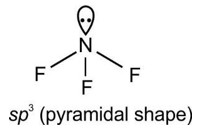The electronic configurations of three elements, A, B and C are given below. Answer the questions 14 to 17 on the basis of these configurations.
A
1S2 2S2 2P6
B
1S2 2S2 2P6 3S2 3P3
C
1S2 2S2 2P6 3S2 3P5
table form of A may be represented by the formula :
(i) A
(ii) A2
(iii) A3
(iv) A4
The electronic configurations of three elements, A, B and C are given below. Answer the questions 14 to 17 on the basis of these configurations.
|
A |
1S2 2S2 2P6 |
|
B |
1S2 2S2 2P6 3S2 3P3 |
|
C |
1S2 2S2 2P6 3S2 3P5 |
table form of A may be represented by the formula :
(i) A
(ii) A2
(iii) A3
(iv) A4
-
1 Answer
-
This is a Multiple Choice Questions as classified in NCERT Exemplar
Ans: Option (i)
The electronic configuration of A 1S2 2S2 2P6 is having no unpaired electrons in the outer most shells. So, an atom having no unpaired electron in its valence shell is said to be stable.
Similar Questions for you
He2 has zero bond order hence it does not exist.
The three fundamental laws of chemistry are - Law of Definite Proportions, Law of Conservation of Mass, and Law of Multiple Proportions.
The three types of chemical bonds are - ionic, metallic and covalent bonds. When the electrons transfer between the atoms, they form the Ionic bonds by producing charged ions that are attracted to each other. When atoms share electrons, covalent bonds are created. When metal atoms share a sea of delocalized electrons, metallic bonds get created.
Taking an Exam? Selecting a College?
Get authentic answers from experts, students and alumni that you won't find anywhere else
Sign Up on ShikshaOn Shiksha, get access to
- 66k Colleges
- 1.2k Exams
- 680k Reviews
- 1800k Answers


